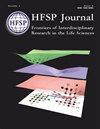Special issue on protein folding: Experimental and theoretical approaches
引用次数: 1
Abstract
Proteins are complex objects able to organize themselves in many different conformations with well-defined motions that are directly involved in biological function. Therefore, protein folding must be composed, in detail, of a complicated network of reactions. Still, it has been described by experimentalists in terms of simple empirical patterns such as linear free energy relationships. This apparent simplicity is a consequence of the global organization of the landscape of energies of protein conformations into a funnel. The field of protein folding has gone through a scientific revolution for about two decades. Our modern understanding of this problem based on energy landscape theory and the funnel concept describes folding as the progressive evolution of an ensemble of partially folded structures through which the protein moves on its way to the native structure. The development of this new understanding of protein folding would be impossible simply by theory and simulation. A new generation of experiments has probed and verified the protein funnel landscape, the existence of minimal frustration and, as a consequence, that the transition state ensemble (viz. the variation in the amount of local native structure) is primarily determined by topological constraints. They have also shown that although a funneled landscape is responsible for the protein folding ability, many different detailed mechanisms must be and have been observed. In the spirit of this new theoretical framework based on energy landscape theory and the funnel concept, a perspective by Wolynes and collaborators discusses the large ensemble of conformational substates of proteins. They comment that since most experiments probe only the low free energy states, this provides a spectrum of excitations that appear simpler than reality. In a funnel-like energy landscape, partially unfolded states compose most of the important excitations but frustration and symmetry are additional alternatives for low free energy excitations. Also guided by energy landscape theory, the perspective by Munoz and collaborators discusses the experimental evidences for one of the great predictions of this theory, the possibility of downhill folding. The article by Levy and collaborators comments on the nature of the unfolded ensemble that in a funnel-like landscape is stabilized by residual native interactions. In the case of repeat proteins, they suggest that this stabilization may also come from non-native contacts, a situation that appears to be less likely for small globular proteins. The protein folding funnel is not perfectly smooth and therefore has some residual ruggedness. The article by Lapidus and collaborators quantifies this ruggedness for the case of protein L. In the early states of energy landscape theory, most of the studies were focused on small fast folding proteins. Lattice models have played a major role in these early developments. As an example see the article by Mann and collaborators. Recently, one has moved towards more exciting and larger systems. The perspective by Clarke and collaborators focuses on the folding of multidomain proteins and investigates how folding can be controlled by individual domains and interactions among them. The article by Jackson and collaborators deals with the folding of green fluorescence protein. This protein has a very complex landscape, where the initial fast folding is followed by very slow events in a superstable core. The perspective by Oliverberg and collaborator connects folding and disease. It discusses how folding and aggregation of the enzyme superoxide dismutase may be responsible for the disease amyotropic lateral sclerosis (ALS). They show that ALS-provoking mutations decrease either protein stability or net repulsive charge—the classical hallmarks for a disease mechanism triggered by association of non-native proteins. The perspective by Aguzzi and collaborators continues on the topic of folding∕misfolding and disease and reviews current techniques for studying prion strain differences in vivo and in cells, and the knowledge gained from modeling prion fibril growth in vitro and in simple organisms. Finally, all these advances in our understanding of protein folding would be impossible without the development of completely new experimental advances that have allowed for probing in details the energy landscape. In this issue some of the most recent and amazing new techniques are described. The perspective by Gruebele and collaborators comments on the novel technique of terahertz spectroscopy, which allows for directly probing protein induced changes in the collective water network. They comment how the solvation shell appears to influence more the native protein than the unfolded or mutated one. The commentary by Ormos discusses how the new technique of two-dimensional-infrared permits the observation of dynamical phenomena directly. This technique has the potential of directly relating structure and detailed dynamics experimentally. The commentary by Schneider discusses how new high-flux x-ray techniques have created the ability of determining protein structure in small crystals; something that was impossible in the near past. Also showing new progress in structural biology, the perspective by Engelman describes recent progress in electron microscopy with particular emphasis on challenges in fitting high-resolution structures into electron microscopic reconstructions. This issue includes an amazing collection of contributions describing the most recent advances in protein folding. The evolution of this field during the last 20 years has been enormous and has shown how theoreticians and experimentalists working together can really transform a field of research. I strongly enjoyed working as a Guest Editor for this special issue. I enjoyed reading every commentary, perspective, and article of this issue and I am certain that you, the reader, will also enjoy reading the articles in this issue. I deeply thank everybody that made this issue possible, especially the authors for their great contributions!关于蛋白质折叠的特刊:实验和理论方法
蛋白质是复杂的物体,能够以许多不同的构象组织自己,具有明确的运动,直接参与生物功能。因此,蛋白质折叠在细节上必须由一个复杂的反应网络组成。尽管如此,实验学家还是用简单的经验模式来描述它,比如线性自由能关系。这种表面上的简单性是蛋白质构象的能量景观整体组织成漏斗的结果。蛋白质折叠领域已经经历了大约二十年的科学革命。我们对这个问题的现代理解是基于能量景观理论和漏斗概念,将折叠描述为部分折叠结构集合的渐进进化,蛋白质通过这些结构向天然结构移动。这种对蛋白质折叠的新认识的发展仅仅通过理论和模拟是不可能的。新一代的实验已经探索并验证了蛋白质漏斗景观,存在最小的挫折,因此,过渡状态集合(即局部天然结构数量的变化)主要由拓扑约束决定。他们还表明,尽管漏斗状的景观是蛋白质折叠能力的原因,但必须并且已经观察到许多不同的详细机制。在这个基于能量景观理论和漏斗概念的新理论框架的精神下,Wolynes及其合作者讨论了蛋白质构象亚态的大集合。他们评论说,由于大多数实验只探测低自由能态,这提供了一个比现实更简单的激发谱。在一个漏斗状的能量景观中,部分展开的状态构成了大多数重要的激发,但挫折和对称是低自由能激发的额外选择。同样在能量景观理论的指导下,Munoz和合作者的观点讨论了该理论的一个重要预测的实验证据,即下坡折叠的可能性。Levy及其合作者的文章评论了在漏斗状景观中由残余的本地相互作用稳定的未展开的集合的性质。在重复蛋白的情况下,他们认为这种稳定也可能来自非原生接触,这种情况似乎不太可能出现在小的球状蛋白上。蛋白质折叠漏斗不是完全光滑的,因此有一些残余的坚固性。Lapidus及其合作者的文章量化了蛋白质l的这种坚固性。在能量景观理论的早期阶段,大多数研究都集中在小的快速折叠蛋白质上。晶格模型在这些早期发展中发挥了重要作用。作为一个例子,请参阅Mann及其合作者的文章。最近,人们转向了更令人兴奋和更大的系统。Clarke和合作者的观点集中在多结构域蛋白质的折叠上,并研究了折叠是如何被单个结构域和它们之间的相互作用所控制的。Jackson及其合作者的文章涉及绿色荧光蛋白的折叠。这种蛋白质的结构非常复杂,最初的快速折叠之后是在一个超稳定的核心中非常缓慢的折叠。奥利弗伯格和合作者的观点将折叠和疾病联系起来。它讨论了酶超氧化物歧化酶的折叠和聚集如何可能负责疾病肌萎缩性侧索硬化症(ALS)。他们发现,引发als的突变降低了蛋白质稳定性或净排斥电荷——这是由非天然蛋白质结合引发的疾病机制的经典标志。Aguzzi和他的合作者继续讨论折叠、错误折叠和疾病的主题,并回顾了目前研究体内和细胞内朊病毒菌株差异的技术,以及从体外和简单生物中模拟朊病毒原纤维生长中获得的知识。最后,如果没有全新的实验进展,我们对蛋白质折叠的理解是不可能取得这些进展的,这些实验进展使我们能够深入探索能量格局的细节。在这一期中,我们将介绍一些最新的、令人惊叹的新技术。Gruebele和合作者的观点评论了太赫兹光谱的新技术,该技术可以直接探测蛋白质诱导的集体水网络的变化。他们评论了溶剂化壳对天然蛋白的影响似乎比未折叠或突变的蛋白更大。Ormos的评论讨论了二维红外新技术如何允许直接观察动力学现象。 该技术具有直接关联结构和详细动力学实验的潜力。Schneider的评论讨论了新的高通量x射线技术如何创造了确定小晶体中蛋白质结构的能力;这在不久的过去是不可能的。Engelman的观点也展示了结构生物学的新进展,描述了电子显微镜的最新进展,特别强调了将高分辨率结构融入电子显微镜重建的挑战。本期杂志收录了大量描述蛋白质折叠最新进展的文章。在过去的20年里,这一领域的发展是巨大的,它表明了理论家和实验家的合作是如何真正改变一个研究领域的。我非常喜欢担任本期特刊的客座编辑。我喜欢阅读本期的每一篇评论、观点和文章,我相信你,读者,也会喜欢阅读本期的文章。我深深感谢所有使这个问题成为可能的人,特别是作者的巨大贡献!
本文章由计算机程序翻译,如有差异,请以英文原文为准。
求助全文
约1分钟内获得全文
求助全文

 求助内容:
求助内容: 应助结果提醒方式:
应助结果提醒方式:


